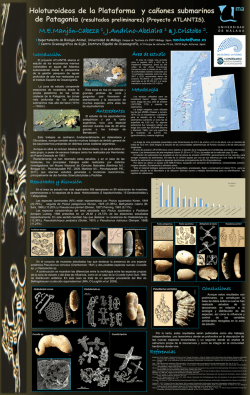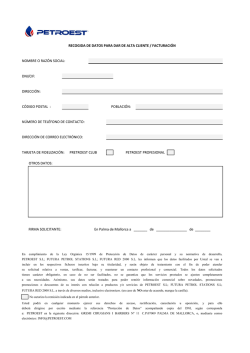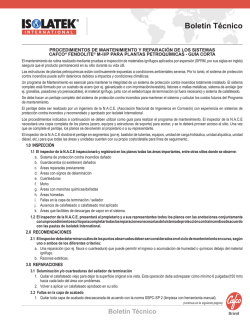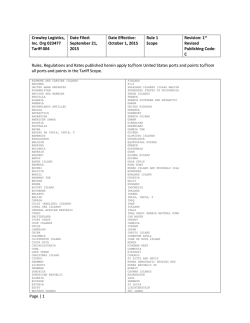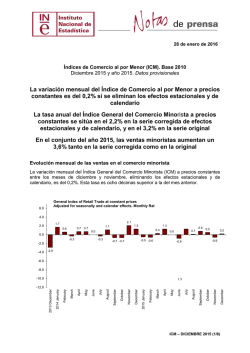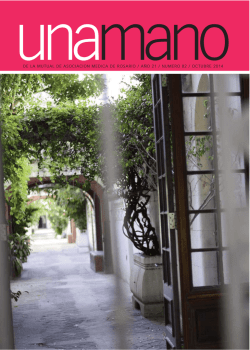
Mariano Ignacio Martinez, Lorena Pilar Arribas, Juan José
Echinoderm diversity in the Southwestern Atlantic Mariano Ignacio Martinez1, Lorena Pilar Arribas1, Juan José Berecoechea1, Martín Ignacio Brogger2 & Pablo Enrique Penchaszadeh1 1. Laboratorio de Ecosistemas Costeros, Museo Argentino de Ciencias Naturales “Bernardino Rivadavia”-CONICET. Buenos Aires, Argentina; mmartí[email protected], [email protected], [email protected], [email protected] 2. Laboratorio de Reproducción y Biología Integrativa de Invertebrados Marinos, Centro Nacional PatagónicoCONICET. Puerto Madryn, Argentina; [email protected] Received 04-VIII-2014. Corrected 13-X-2014. Accepted 21-XI-2014. Abstract: Studies of biodiversity of echinoderms from South America have increased in recent years. Here we summarize sampling done on three expeditions along the Argentinean coast (35º - 55º S) and near the Antarctic Peninsula. The first campaign, Mejillón II (M-II; 2009), was carried out between 35º - 39º S and covered a depth range between 10 to 140 m. The second was part of the Summer Antarctic Campaign 2011 (CAV-III; 2011) that took place around the Antarctic Peninsula, South Shetland and South Orkney Islands (depth range between 67 to 754 m). The last cruise was the final stretch of the Summer Antarctic Campaign 2011 (CAV-IV; 2011), from 39º - 55º S and between 30 - 140 m depth. As result, 74 stations have been studied, of which 68 had at least one echinoderm specimen. From the total number of stations, the occurrence percentages for each class were Asteroidea (68 %), Echinoidea (64 %), Ophiuroidea (55 %), Holothuroidea (51 %) and Crinoidea (20 %). In the M-II campaign, echinoderms were presented in 94 % of the sampled stations, with Echinoidea most frequent (74 %). In the CAV-III campaign echinoderms were presented in all the stations; Ophiuroidea were found in all stations. The lowest occurrence of echinoderms was found in the CAV-IV campaign (82 %), where Asteroidea was present in the 73 % of the samples, and crinoids were absent. Rev. Biol. Trop. 63 (Suppl. 2): 115-120. Epub 2015 June 01. Key words: Echinodermata, biodiversity, B/O Puerto Deseado, Argentine Sea, Antarctica. Studies of biodiversity of echinoderms from South America increased in the last years, leading to the recent publication of the book “Studies in Echinoderms from Latin America” (Alvarado & Solís-Marín, 2013). Particularly, for the Argentine Sea, several researchers have been studying reproduction in asteroids, echinoids, holothuroids and ophiuroids (Rubilar, Pastor de Ward & Díaz de Vivar, 2005; Marzinelli, Bigatti, Giménez & Penchaszadeh, 2006; Gil & Zaixso 2007; Brogger, Martinez & Penchaszadeh, 2010, 2013; Pérez, Boy, Morriconi & Calvo , 2010; Martinez, Giménez & Penchaszadeh, 2011), taxonomy of holothuroids and asteroids (Hernández, 1981, 1982; Hernández & Tablado, 1985; Martinez & Brogger, 2012; Martinez, Thandar & Penchaszadeh, 2013; Martinez, Solís-Marín & Penchaszadeh, 2014), ecology of asteroids (Brogger & Penchaszadeh, 2008; Gil & Zaixso, 2008), local biogeography of echinoderms (Zaixso & Lizarralde, 2000; Souto, Escolar, Genzano & Bremec, 2014), and physiology of echinoids and asteroids (Rubilar, Pastor de Ward & Díaz de Vivar, 2006; Pérez, Boy, Morriconi & Calvo, 2008). Since 2009, studies on benthic communities were enhanced by the assistance of the oceanographic vessel B/O Puerto Deseado from CONICET (National Scientific and Tecnological Council). New descriptions of species as Thandarum hernandezi Martinez & Brogger, Rev. Biol. Trop. (Int. J. Trop. Biol. ISSN-0034-7744) Vol. 63 (Suppl. 2): 115-120, June 2015 115 2012, Havelockia pegi Martinez, Thandar & Penchaszadeh, 2013, Armadillogorgia arbertoi Cerino & Lauretta, 2013, Benthodytes violeta Martinez, Solís-Marín. & Penchaszadeh, 2014 among others, have resulted from campaigns performed by the oceanographic vessel along the Argentine coasts at different depths (Martinez & Brogger, 2012; Martinez et al., 2013; Cerino & Lauretta, 2013; Chiesa & Alonso, 2014; Martinez et al., 2014; Pastorino & Signorelli in press). In this work we summarize the Echinodermata fauna collected during three expeditions, one from Antarctica and two from the Argentine Sea. The main goal of this report is to contribute on the knowledge of diversity of echinoderms, studying the proportion among classes and among the three campaigns in the Southwestern Atlantic Sea in order to update recent revisions and to enhance future contributions on the subject. MATERIALS AND METHODS The study was conducted in the Southwestern Atlantic Ocean, along the coast of Argentina. Three campaigns were performed: Mejillón II (hereafter M-II; Fig. 1 A), Summer Antarctic Campaign 2011 (CAV-III; Fig. 1 B) and the final stretch of the Summer Antarctic Campaign 2011 (CAV-IV; Fig. 1 C). M-II was conducted from 35º S to 39º S, between 10 and 140 m depth (31 stations) from September 9th to September 20th 2009. CAV-III took place around the Antarctic Peninsula, South Shetland and South Orkney Islands, covering 67-754 m depth (21 stations) from March 15th to March 27th 2011. CAV-IV corresponds to the final part of the Summer Antarctic Campaign conducted between 39º S and 55º S, at 30-140 m depth (22 stations) from March 15th to March 27th 2011. Samples were taken using fishing net and a dredge trawl. All samples were sorted, identified to the lowest taxonomic level possible and stored in 96 % ethanol. For each station the presence of each echinoderm class was analyzed, and the proportions were represented. 116 RESULTS A total of 74 stations were analyzed in this work, of which in 68 was found at least one echinoderm individual (92 %). The total number of stations where each class appeared was: Asteroidea 50 (68 %), Echinoidea 47 (64 %), Ophiuroidea 41 (55 %), Holothuroidea 38 (51 %) and Crinoidea 15 (20 %) (Fig. 2 A). In M-II campaign, 94% of the stations had a positive record of echinoderms, being Echinoidea the most common class (74 %; Fig. 2 B). For all CAV-III stations echinoderms were collected and Ophiuroidea was the best represented group. From the total of the stations at CAV-III, Ophiuroidea showed 100 % of occurrence and Asteroidea was the second with 90.5 %. On the other hand Crinoidea showed the lowest with 66.7 % (Fig. 2 C). Echinoderms were possible to obtain at 82 % of the stations during CAV-IV, being the lowest value comparing with the other two campaigns. Asteroidea had 73 % of representation during CAV-IV, in contrast, Crinoids were not found in this sampling (Fig. 2 D). DISCUSSION Echinoderms are well represented along the Argentine coast and Antarctica, since of the 74 stations only six have negative occurrence of echinoderms, reinforcing observations of other authors (e.g., O´Loughlin, Paulay, Davey & Michonneau, 2011). In this study all five classes of Echinodermata were present, which is in accordance with observed by different authors that studied the fauna of the Argentine Sea and Antarctica (O´Loughlin, 2002; Eléaume, Bohn, Roux & Améziane, 2012; Stöhr, O’Hara & Thuy 2012; Brogger et al., 2013). At the Argentine Sea, Asteroidea is the most representative class. At CAV-IV, 72.7 % of the total stations showed sea stars (Fig. 2 D). This observation is consistent with Brogger et al. (2013) whom indicated that for this area Asteroidea is the most speciose class (58 %). As for M-II campaign, the fauna from the Buenos Aires coast presented all the classes. Rev. Biol. Trop. (Int. J. Trop. Biol. ISSN-0034-7744) Vol. 63 (Suppl. 2): 115-120, June 2015 Fig. 1. Maps showing stations from all the campaigns treated. (A) M-II; (B) CAV-III; (C) CAV-IV. Fig. 1. Mapas indicando las estaciones de todas las campañas realizadas. (A) M-II; (B) CAV-III; (C) CAV-IV. Bernasconi (1941) described six species of Asteroidea, four of Echinoidea, three of Ophiuroidea and only one of Holothuroidea from that region, with no records of Crinoidea. At that study she analyzed species that were collected up to 109 m. The Crinoidea from the M-II was collected at 145 m, which could explain why Crinoidea were not described in previous studies (Fig. 2 B). The high number of echinoderms present per stations for the M-II could be related with the high productivity in this area by the confluence between Brazil and Malvinas currents (Rivas, Dogliotti & Gagliardini, 2006; Brogger et al., 2013). In Antarctica (CAV-III), echinoderms appear in all the studied stations (Fig. 2 C). On the contrary and apart from the close and affinities reported by de Moura Barboza, Rev. Biol. Trop. (Int. J. Trop. Biol. ISSN-0034-7744) Vol. 63 (Suppl. 2): 115-120, June 2015 117 understanding of these phyla in the Argentine Sea and near waters. This work could lead to a global known of these benthic communities. ACKNOWLEDGMENTS We thank the crew of the B/O Puerto Deseado, and especially to all the participants of the first Latin American Echinoderm Congress (CLE) for providing productive discussions about biogeography and on species diversity and distribution. Authors are members of CONICET. Partial financial support was provided by Consejo Nacional de Investigaciones Científicas y Técnicas (CONICET PIP0253) and by Agencia Nacional de Promoción Científica y Tecnológica (PICT 2012-0561 and PICT 2013-2504). RESUMEN Fig. 2. Bars showing percentage for each echinoderm class (A) All the campaigns; (B) M-II; (C) CAV-III; (D) CAV-IV. H: Holothuroidea, C: Crinoidea, A: Asteroidea, E: Echinoidea, O: Ophiuroidea. Fig. 2. Barras indicando el porcentaje para cada clase de equinodermo (A) Todas las campañas; (B) M-II; (C) CAV-III; (D) CAV-IV. H: Holothuroidea, C: Crinoidea, A: Asteroidea, E: Echinoidea, S: Ophiuroidea. de Moura, Lanna, Oackes and Campos (2011), Argentine Sea presents in this study a different scenario with some stations with no echinoderms. This great appearance of the phylum in Antarctica leads to some authors to define Antarctica as a hot spot of echinoderms diversity (O´Loughlin et al., 2011). This short report contributes to the knowledge about relationship within classes of this group at the Southwestern Atlantic, an area of high diversity and with benthic communities with a high presence of echinoderms. Future works will study and describe the species not yet analyzed. Besides, studies on the interactions between echinoderms and other invertebrates are going to be the next step for a better 118 Diversidad de equinodermos del Atlántico suroccidental. En los últimos años se han incrementado los estudios sobre la biodiversidad de equinodermos de Latinoamérica. En el presente trabajo, se exponen los resultados sobre muestras obtenidas en tres expediciones a lo largo de la costa argentina (35 - 55º S) y cerca de la Península Antártica. La primera campaña analizada, Mejillón II (M-II; 2009), se llevó acabo entre 35º - 39º S cubriendo profundidades entre 10 y 140 m. La segunda, parte de la Campaña Antártica de Verano 2011 (CAV-III; 2011), tuvo lugar en el área de la Península Antártica, Shetland del Sur e islas Orcadas del Sur (profundidad entre 67 hasta 754 m). La última expedición analizada en este trabajo fue el último tramo de la Campaña Antártica de Verano (CAV-IV; 2011) desde 39º - 55º S y entre 30 - 140 m de profundidad. Como resultado, 74 estaciones fueron estudiadas, en las cuales en 68 se encontró al menos un espécimen del Phylum Echinodermata. Considerando todas las estaciones, el porcentaje de encuentro para cada clase fue Asteroidea (68 %), Echinoidea (64 %), Ophiuroidea (55 %), Holothuroidea (51 %) and Crinoidea (20 %). En la campaña M-II, los equinodermos estuvieron presentes en el 94 % de las estaciones muestreadas, siendo Echinoidea el más frecuente (74 %). En relación a la Campaña CAV-III, los equinodermos estuvieron presentes en todas las estaciones muestreadas; Ophiuroidea fue la clase más representativa en número de estaciones (100 %). El valor más bajo de aparición de equinodermos fue encontrado en la campaña CAV-IV (82 %), donde Asteroidea estuvo presente en el 73 % de las muestras, y los crinoideos estuvieron ausentes. Rev. Biol. Trop. (Int. J. Trop. Biol. ISSN-0034-7744) Vol. 63 (Suppl. 2): 115-120, June 2015 Palabras clave: Echinodermata, Biodiversidad, B/O Puerto Deseado, Mar Argentino, Antártida. REFERENCES Alvarado, J. J., & Solís-Marín, F. A. (Eds.) (2013). Echinoderms Research and Diversity in Latin America. Berlin: Springer. Bernasconi, I. (1941). Buque Oceanográfico “Comodoro Rivadavia” A.R.A. Physis, 19, 37-49. Brogger, M. I., & Penchaszadeh, P. E. (2008). Infaunal mollusks as main prey for two sand bottoms sea stars off Puerto Quequén (Argentina). Revista de Biología Tropical, 56(Suppl. 3), 329-334. Brogger, M. I., Martinez, M. I., & Penchaszadeh, P. E. (2010). Reproduction of the sea urchin Arbacia dufresnii (Echinoidea: Arbaciidae) from Golfo Nuevo, Argentina. Journal of Marine Biological Association of UK, 90, 1405-1409. Brogger, M. I., Gil, D. G., Rubilar, T., Martinez, M. I., Díaz de Vivar, E., Escolar, M., … Tablado, A. (2013). Echinoderms from Argentina: Biodiversity, distribution and current state of knowledge. In J. J. Alvarado & F. A. Solís-Marín (Eds.), Echinoderms Research and Diversity in Latin America (pp. 359-402). Berlin: Springer. Cerino, N., & Lauretta, D. M. (2013). Armadillogorgia albertoi sp. nov.: a new primnoid from the Argentinean deep sea. Zootaxa, 3741, 369-376. Chiesa, I., & Alonso, G. M. (2014). A new genus and species of Platyischnopidae (Amphipoda: Gammaridea) from the Argentine Sea, South-West Atlantic Ocean. Zootaxa, 3811, 34-52. de Moura Barboza, C. A., de Moura, R. B., Lanna, A. M., Oackes, T., & Campos, L. S. (2011). Echinoderms as clues to Antarctic - South American connectivity. Oecologia Australis, 15, 86-110. Eléaume, M., Bohn, J. M., Roux, A., & Améziane, N. (2012). Stalked crinoids (Echinodermata) collected by the R/V Polarstern and Meteor in the south Atlantic and in Antarctica. Zootaxa, 3425, 1-22. Gil, D. G., & Zaixso, H. E. (2007). The relation between feeding and reproduction in Anasterias minuta (Asteroidea: Forcipulata). Marine Biology Research, 3, 256-264. Gil, D. G., & Zaixso, H. E. (2008). Feeding ecology of the subantarctic sea star Anasterias minuta within tide pools in Patagonia, Argentina. Revista Biología Tropical, 56(Suppl. 3), 311-328. Hernández, D. A. (1981). Holothuroidea de Puerto Deseado (Santa Cruz, Argentina). Revista del Museo Argentino de Ciencias Naturales “Bernardino Rivadavia”, 4, 151-168. Hernández, D. A. (1982). Holothuroidea des Sudwestatlantiks I. Die Trachythyone-Arten. Mitteilungen aus dem Hamburgischen Zoologischen Museum und Institut, 79, 251-261. Hernández, D. A., & Tablado, A. (1985). Asteroidea de Puerto Deseado (Santa Cruz, Argentina). Contribuciones del Centro Nacional Patagónico del Consejo Nacional de Investigaciones, 104, 1-16. Martinez, M. I., & Brogger, M. I. (2012). Thandarum hernandezi, a new genus and new species of sea cucumber family Sclerodactylidae (Echinodermata: Holothuroidea: Dendrochirotida) from the Southwestern Atlantic Ocean. Zootaxa, 3304, 63-68. Martinez, M. I., Giménez, J., & Penchaszadeh, P. E. (2011). Reproductive cycle of the sea cucumber Psolus patagonicus Ekman 1925, off Mar del Plata, Buenos Aires, Argentina. Invertebrate Reproduction & Development, 55, 124-130. Martinez, M. I., Thandar, A. S., & Penchaszadeh, P. E. (2013). A new species of Havelockia Pearson, 1903 from the Argentine Sea (Holothuroidea: Dendrochirotida: Sclerodactylidae). Zootaxa, 3609, 583-588. Martinez, M. I., Solís-Marín, F. A., & Penchaszadeh, P. E. (2014). Benthodytes violeta, a new species of a deep-sea holothuroid (Elasipodida: Psychropotidae) from Mar del Plata Canyon (south-western Atlantic Ocean). Zootaxa, 3760, 89-95. Marzinelli, E. M., Bigatti, G., Giménez, J., & Penchaszadeh P. E. (2006). Reproduction of the sea urchin Pseudechinus magellanicus (ECHINOIDEA: TEMNOPLEURIDAE) from Golfo Nuevo, Argentina. Bulletin of Marine Science, 79, 127-136. O´Loughlin, M. (2002). Report on selected species of Banzare and Anare Holothuroidea, with reviews of Meseres Ludwig and Heterocucumis Panning (Echinodermata). Memoirs of Museum Victoria, 59, 297-325. O´Loughlin, P. M., Paulay, G., Davey, N., & Michonneau, F. (2011). The Antarctic region as a marine biodiversity hotspot for echinoderms: Diversity and diversification of sea cucumbers. Deep-Sea Research II, 58, 264-275. Pérez, A.F., Boy, C., Morriconi, E., & Calvo, J. (2008). Seasonal changes in energy allocation to somatic and reproductive body components of the common cold temperature sea urchin Loxechinus albus in a SubAntarctic environment. Polar Biology, 31, 443-449. Pérez, A. F., Boy, C., Morriconi, E., & Calvo, J. (2010). Reproductive cycle and reproductive output of the sea urchin Loxechinus albus (Echinodermata: Echinoidea) from Beagle Channel, Tierra del Fuego, Argentina. Polar Biology, 33, 271-280. Rivas, A. L., Dogliotti, A. I., & Gagliardini, D. A. (2006). Seasonal variability in satellite-measured surface Rev. Biol. Trop. (Int. J. Trop. Biol. ISSN-0034-7744) Vol. 63 (Suppl. 2): 115-120, June 2015 119 chlorophyll in the Patagonian Shelf. Continental Shelf Research, 26, 703-720. Rubilar, T., Pastor de Ward, C. T., & Díaz de Vivar, M. E. (2005). Sexual and asexual reproduction of Allostichaster capensis (Echinodermata: Asteroidea) in Golfo Nuevo. Marine Biology, 146, 1083-1090. Rubilar, T., Pastor de Ward, C., & Díaz de Vivar, E. (2006). Timing of fission in the starfish Allostichaster capensis (Echinodermata: Asteroidea) in laboratory. Revista Biología Tropical, 53 (Suppl. 3), 299-303. Signorelli, J. H., & Pastorino, G. (2015). A new Species of Laubiericoncha (Bivalvia: Vesicomyidae) from deep waters off Argentina. Malacología, 58(2), 349-360. 120 Souto, V., Escolar, M., Genzano, G., & Bremec, C. (2014). Species richness and distribution patterns of echinoderms in the southwestern Atlantic Ocean (34-56°S). Scientia Marina, 78, 269-280. Stöhr, S., O’Hara, T. D., & Thuy, B. (2012). Global Diversity of Brittle Stars (Echinodermata: Ophiuroidea). Plos One, 7, 1-14. Zaixso, H. E., & Lizarralde, Z. I. (2000). Distribución de equinodermos en el golfo San José y sur del golfo San Matías (Chubut, Argentina). Revista de Biología Marina y Oceanografía, 35, 1-19. Rev. Biol. Trop. (Int. J. Trop. Biol. ISSN-0034-7744) Vol. 63 (Suppl. 2): 115-120, June 2015
© Copyright 2025
